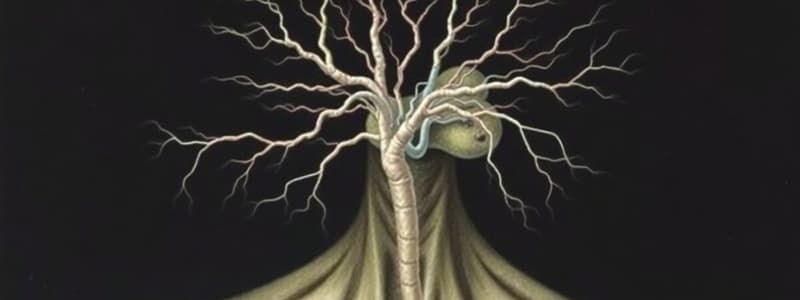Podcast
Questions and Answers
What are the two major divisions of the nervous system?
What are the two major divisions of the nervous system?
- Brain and Spinal Cord
- Neurons and Glia
- Somatic and Autonomic
- Central and Peripheral (correct)
The brain is not part of the central nervous system.
The brain is not part of the central nervous system.
False (B)
What is the fundamental cell of the nervous system called?
What is the fundamental cell of the nervous system called?
neuron
The peripheral nervous system connects the central nervous system to the rest of the ________.
The peripheral nervous system connects the central nervous system to the rest of the ________.
Which part of the neuron typically receives signals from other neurons?
Which part of the neuron typically receives signals from other neurons?
The autonomic nervous system controls voluntary movements like walking.
The autonomic nervous system controls voluntary movements like walking.
What is the gap between two neurons called where communication occurs?
What is the gap between two neurons called where communication occurs?
The ________ nervous system is responsible for the 'fight or flight' response.
The ________ nervous system is responsible for the 'fight or flight' response.
Which of the following is NOT a function of glial cells?
Which of the following is NOT a function of glial cells?
Sensory neurons carry information from the brain to the muscles.
Sensory neurons carry information from the brain to the muscles.
Flashcards
Neurons
Neurons
The fundamental units of the nervous system, responsible for transmitting information.
Dendrites
Dendrites
Branch-like extensions of a neuron that receive signals from other neurons.
Axon
Axon
The part of the neuron that transmits signals away from the cell body to other neurons, muscles, or glands.
Myelin Sheath
Myelin Sheath
Signup and view all the flashcards
Synapse
Synapse
Signup and view all the flashcards
Neurotransmitters
Neurotransmitters
Signup and view all the flashcards
Central Nervous System (CNS)
Central Nervous System (CNS)
Signup and view all the flashcards
Peripheral Nervous System (PNS)
Peripheral Nervous System (PNS)
Signup and view all the flashcards
Somatic Nervous System
Somatic Nervous System
Signup and view all the flashcards
Autonomic Nervous System
Autonomic Nervous System
Signup and view all the flashcards
Study Notes
- The nervous system is a complex network that enables organisms to receive, process, and respond to stimuli from both internal and external environments.
- It is responsible for coordinating and regulating bodily functions and activities.
- It is divided into two major divisions: the central nervous system (CNS) and the peripheral nervous system (PNS).
Central Nervous System (CNS)
- Composed of the brain and spinal cord.
- The brain serves as the control center, responsible for processing information, decision-making, and initiating responses.
- The spinal cord serves as a pathway for transmitting information between the brain and the peripheral nervous system.
- It also mediates reflexes.
Peripheral Nervous System (PNS)
- Consists of all the nerves and ganglia outside of the brain and spinal cord.
- It is responsible for transmitting information between the CNS and the rest of the body.
- Divided into two main subdivisions: the somatic nervous system and the autonomic nervous system.
Somatic Nervous System
- Controls voluntary movements of skeletal muscles.
- It transmits sensory information from the sensory organs to the CNS and conveys motor commands from the CNS to the muscles.
Autonomic Nervous System
- Regulates involuntary functions such as heart rate, digestion, respiration, and glandular secretions.
- It operates without conscious control.
- Further divided into the sympathetic and parasympathetic nervous systems.
Sympathetic Nervous System
- Prepares the body for action in stressful or emergency situations, often referred to as the "fight-or-flight" response.
- Increases heart rate, dilates the pupils, inhibits digestion, and stimulates the release of glucose for energy.
Parasympathetic Nervous System
- Promotes relaxation, conserves energy, and restores normal bodily functions, often referred to as the "rest-and-digest" response.
- Slows down heart rate, constricts the pupils, stimulates digestion, and promotes relaxation.
Neurons
- The basic building blocks of the nervous system.
- Specialized cells responsible for transmitting information throughout the body.
- Composed of three main parts: the cell body, dendrites, and axon.
Cell Body
- Contains the nucleus and other cellular organelles.
- It is responsible for the metabolic functions of the neuron.
Dendrites
- Branch-like extensions that receive signals from other neurons.
- Transmit them towards the cell body.
Axon
- A long, slender projection that transmits signals away from the cell body to other neurons, muscles, or glands.
- Axons are often covered by a myelin sheath, which insulates the axon and increases the speed of signal transmission.
Synapses
- The junctions between neurons where communication occurs.
- When an action potential reaches the axon terminal, it triggers the release of neurotransmitters into the synaptic cleft.
- These neurotransmitters bind to receptors on the postsynaptic neuron, leading to either excitation or inhibition of the postsynaptic neuron.
Studying That Suits You
Use AI to generate personalized quizzes and flashcards to suit your learning preferences.



